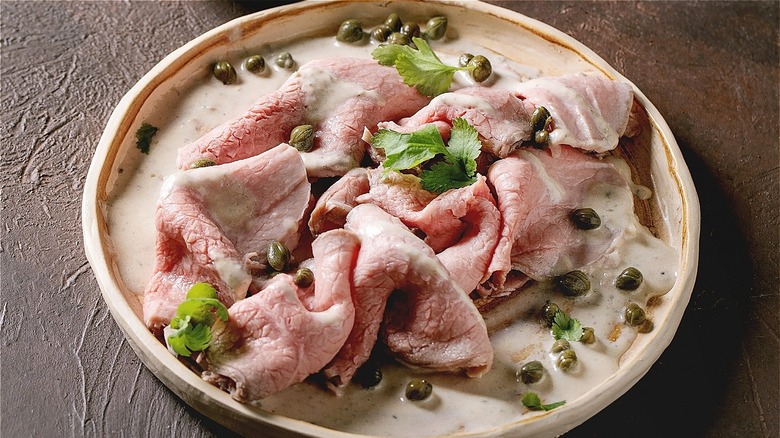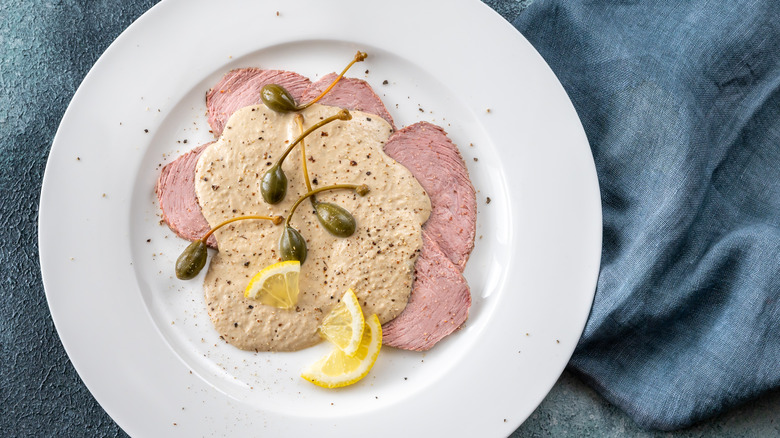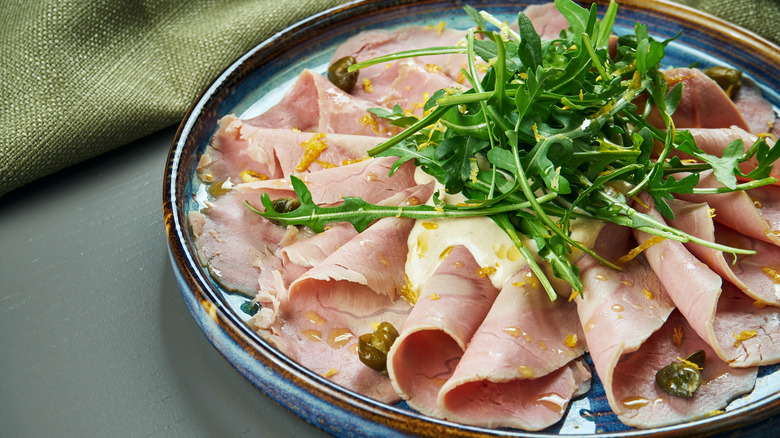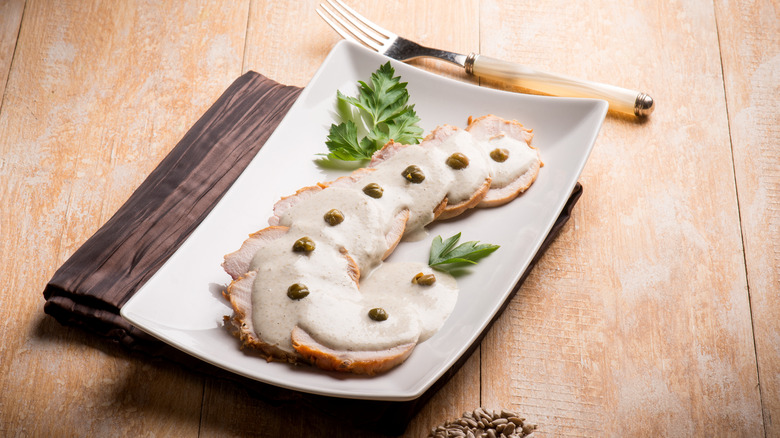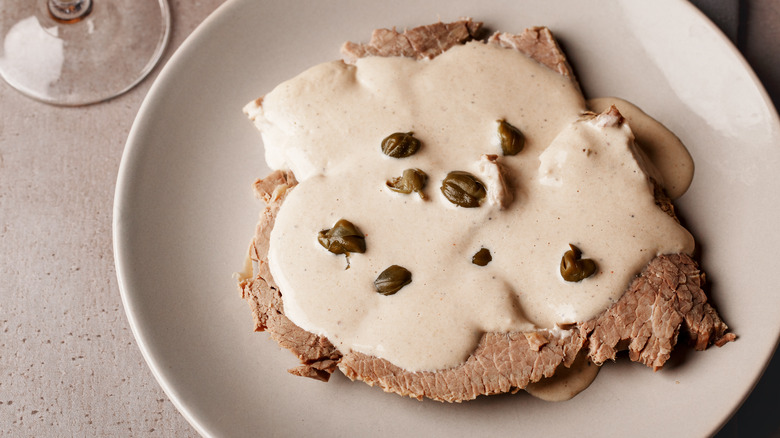What Is Vitello Tonnato And What Does It Taste Like?
To the uninitiated, a mix of veal, mayonnaise, capers, and tuna may not sound especially appealing. In actuality, vitello tonnato is much more than the sum of its parts. With Italian origins reaching back for centuries, vitello tonnato is a classic cold dish, but one that is still relatively under-appreciated outside of Italy. Almost like an Italian surf and turf of sorts, the dish's individual ingredients seem disparate, but once combined, the flavors are unforgettable.
Sometimes simply called "veal with tuna sauce," vitello tonnato hails from northern Italy, according to Serious Eats. It traditionally consists of cooked, cold, thin slices of veal (though many experiment with other proteins) topped with a rich, creamy, assertive sauce containing capers, lemon, anchovies, and tuna. The sauce shouldn't be especially viscous, but it should be pourable and easily spoonable over the veal. The Spruce Eats notes that the refreshing specialty is most popular in Italy in the summertime, especially on the Ferragosto holiday, and Saveur says it's also special enough to be served on Christmas.
What are the origins of vitello tonnato?
La Cucina Italiana speculates that vitello tonnato originated in the 1700s in the northern Italian region called Piedmont — and it originally didn't contain any tuna. The name, instead, is a reference to the way the veal was "tanned," or boiled for a lengthy period to ensure prime tenderness. Much later, a famous Italian cookbook from 1891 described the dish as boiled and sliced veal with the tuna, anchovy, lemon, and caper sauce that we still eat in the 21st century.
MasterClass, meanwhile, reports that vitello tonnato was born in the mid-1800s and was one of the first dishes to bridge the meat-fish divide, as most cooks used to keep proteins and fish entirely separate. The name vitello tonnato wasn't actually coined until 1862, when a chef from Milan named Angelo Dubini called it as such in his cookbook. By 1950, the recipe had been modernized: "The Silver Spoon" cookbook added pre-made mayonnaise to the sauce, which helped streamline the cooking process. Plus, canned tuna had become widely available, making vitello tonnato more accessible to the average household.
What does it taste like?
Italy Magazine says that the umami flavors of vitello tonnato set it apart from other dishes. Traditionally served as an antipasto (appetizer), it's a deeply savory, memorable way to start a meal. It has a decadent mouthfeel, with the bright and creamy sauce enhancing the mildly meaty flavors inherent in the chilled veal. As for the way the sauce should taste, there seem to be two schools of thought: Some recipes essentially treat it as a mayonnaise that is zhuzhed up with fish and aromatics, while other chefs prioritize the tuna and anchovies, making it creamy with egg and oil. In either case, emulsification is key.
Vitello tonnato is also briny from the capers and acidic from the lemon, two ingredients that give this otherwise rich dish a lighter touch. Since it contains both meat and fish, it can seamlessly fit into any menu, whether you want to follow it up with spaghetti and clams or a hearty vegetable dish. And though it is meant to be served as a first course, Italy Magazine says it's not against Italian law to enjoy it for lunch with a bit of salad.
Nutritional information about vitello tonnato
The ingredients found in vitello tonnato boast a bevy of health benefits. Tuna, for one, is a high-quality protein source providing vitamin D, essential minerals, and omega-3 fatty acid — whether you use canned or fresh, per Healthline. While anchovies may be a bit polarizing, they're also a very nutritional offering, boasting healthy fats, vitamin B3, and minerals that can aid in heart, lung, immune, and bone health (via Healthline). Just be sure to rinse salt-packed anchovies (and capers) to avoid excess sodium intake.
Verywell Fit notes that veal is high in protein, low in fat, and has many vitamins and minerals. It is also said to improve cholesterol health, strengthen muscles, and reduce blood pressure. Some also believe it's a healthier alternative to beef. And if you boil it, as is customary for vitello tonnato, you won't need to add additional oil or fat during the cooking process. Meanwhile, the extra-virgin olive oil found in the sauce — full of beneficial fats and antioxidants — could help you live longer. Those wanting to serve vitello tonnato as a full meal may consider supplementing the protein and fats with a side of whole grains or vegetables.
How to make vitello tonnato
As Italy Magazine notes, making vitello tonnato is a relatively easy but lengthy process since the veal needs to cool completely before serving. Traditionally, you would boil the veal one day, leave it in the fridge to cool overnight, and top it with the sauce the next day — a method that could appeal to entertainers who appreciate make-ahead dishes for dinner parties. Theoretically, though, you could boil the veal in the morning and still enjoy it the same day for lunch or dinner.
A Food Network recipe calls for boneless veal top round, which you simmer in a flavorful broth of water, white wine, carrots, onion, celery, garlic, and an herb bundle of parsley, bay leaf, and rosemary or thyme. Let it cool before slicing it, then make the sauce by buzzing up canned tuna, anchovies, capers, oil, and lemon zest and juice in a food processor until very smooth. Combine this with mayonnaise and spread it over a platter of the sliced veal — which you can refrigerate for several hours in order to let the flavors meld. (To go the non-mayonnaise route, you'd whip the sauce ingredients with egg and slowly drizzle in the oil to emulsify, as Serious Eats recommends.)
Of course, all recipes differ slightly, and customization is welcome. Whether you use pork tenderloin in place of the veal, opt for a roast instead of a boil, or top your vitello tonnato with a non-traditional arugula salad, one tip is universal: Taste your sauce often for seasoning, as the salty anchovies and capers are already pretty assertive.
